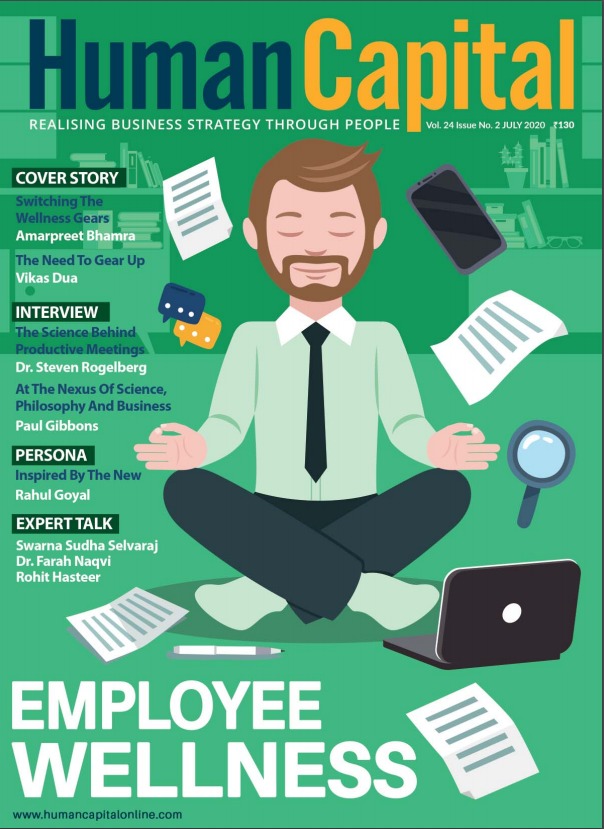For a wellness programme to succeed, it is imperative that we reach out to our employees and make them a core part of the decision making.
Organisations that visualise human resources as people first and employees next are the ones that succeed in creating a robust wellness strategy that truly represents a ‘Wellness Culture’ everyone loves and resonates to. What more accomplished way to express employee care than by making a meaningful investment in their overall wellbeing! Even with the known benefits of wellness programmes such as lowered health cost, increased benefits, happy and productive employees – much needs to be achieved in the direction of establishing an employee wellness strategy that truly works. It is therefore essential to explore ways of putting together a successful framework of wellness culture, and taking a holistic approach to improve the employee experience through wellness initiatives, both in and out of the workplace.
Engage and Involve Employees
Most employers fail to understand this. For a wellness programme to succeed, it is imperative that we reach out to our employees and make them a core part of the decision making. We need to put together a laundry list of wellness dynamics, educate employees of the benefits, and then roll out a survey to understand what gels best with them and spin your strategy around it. Conventional wisdom and research tell us that people engage in something when they perceive that they have managed to get a good deal. When employees are empowered to select programmes, you fulfil the assertion of WIFM (What’s In it For Me)! This forms the seed of creating a successful wellness programme – and this approach now speaks to the employees need and generates an outcome that employees find desirable and beneficial, and thus, there is an automatic increase in interest!
Focus on Intrinsic Motivation
The true value of Wellness Culture is sustainability. How do you ensure employee motivation does not slip away? The approach of intrinsic motivation allows for a longterm impact where employees display behaviour as continued progress because the behaviour is selfrewarding. How can this be achieved?
♦ Select programmes that address a behaviour employee ‘can do’ and ‘want to do’ because their WIFMs are clear and merged with their values and belief system
♦ Encourage a committed leadership team that self participates, proactively supports the programme and actively encourages employee participation
♦ Highlight the values it holds like “A healthy lifestyle is a rewarding lifestyle’ – ‘Be a role model for others’ or ‘lead by example’
♦ Be high on celebrating success. Be loud on recognising employees who make progress in their personal goals. Make public call outs for employees that do a bit more, shine a bit more and bring a bit more energy to the programme and peers alike
Give less weightage to Extrinsic Motivation that runs on cash incentive pay out. It provides a shortlived burst of motivation that fades quickly and completely dies if incentives are pulled off. How many steps do you think an employee would take if some incentive amount was attached to completing 5,000 steps? 5,000 or at best 5,001? Would employees do 10,000? Just about a handful!
Identify Your Internal Champions
Identify employees from crossfunctions who can be your voice to a larger group. They will help ensure the programme stays its course of intended ROI. This group can be titled ‘employee wellness club’ to carry out the following advantages in your favour:
♦ To build and sustain the wellness culture in the organization
♦ Evaluate the programmes impact, influence and desired benefit
♦ Be your promoters and feed inputs on how things are moving at ground level
♦ Assist with reiterating the objectives and goals of the overall wellness programme
♦ Encourage peers and build the right momentum at a company level
“Unhealthy employees are more likely to disengage and are 43% more likely to have increased stress and anxiety,” says Dr Kevan Orvitz, CEO at MEGAComfort, a wellness tech company. Your internal champions can help you fight this concern effectively.
Strategic Communication – the most critical building block for wellness success!
According to a research by Harvard Business Review, 58% of organisations report that employees are unaware of the health and wellness benefits. Hence, your goal is to ensure that the programme information is both visible and accessible to all employees. To adopt a maximum positive impact, treat it how the marketing team would strategise communication for the release of a new product. Build loads of enthusiasm by selecting multiple communication channels through different internal campaigns.
Consider the following:
♦ Create attractive flyers, banners, inspirational emails from CEOs desk and posters to spread the eyeball reach on both internal intranet and social media alike
♦ Have wellness related short video clips uploaded on HRMS platform
♦ Use fancy slogans such as ‘Whacky Twisted Friday’ or ‘Shake a Leg Wednesday’
♦ Make it a part of your quarterly business review – evaluate and measure your programme
♦ Include it in your reward and recognition programme
♦ Collect & publish testimonials of employees benefiting from the programme
♦ Involve leaders in your organisation to promote the efforts proactively
♦ Make communication happen both ways - roll out periodic survey for feedback to continuously refine the programme
♦ It must be a part of your new employee orientation
Communication on employee wellness programme must be strategic and ongoing with the need of constant marketing. If you do this smartly, you make a significant influence in creating your own wellness culture that can thrive beyond imagination!
Befriend Technology while capturing the Human Touch
Tech today is inseparable in almost everything we do, and the employee wellness programme is no different. What I would emphasise here is on the virtue of human touch. To make your wellness programme complete and meaningful you need to bring in the following attribute to your employees:
♦ Live consultations on topics like mental and emotional wellbeing
♦ Chat online option with a qualified doctor to address any employee and their family health query
♦ Online helpdesk support to understand insurance benefit or questions around deductibles to offering advice on managing anxiety to depression
♦ Parental advice, mother care and even managing child psychology
♦ Provide tools in your platform to allow employees to get their health screening done, use health calculators and health navigators while also taking a health risk assessment
♦ Merge this with personalised reports along with a professional to get proper guidance to make necessary lifestyle corrections
It is important to understand that we need to extend our programme and include diverse aspect of wellness – mental, emotional, physical and psychological well-being as well.
Be tough to establish a Budget
Establishing a budget is a critical step as without designated funding, the programme will freeze to death. Put careful thought to all activities and spends involved and ensure you get a wellness programme budget as a default component in your HR budget – this must not be compromised or undermined in any way
To bring it all together
The younger workforce is increasingly comfortable with discussing overall individual wellbeing and even mental health openly. They are forthcoming to act on it. HR must quickly rise to the occasion, tap into the openness of this expressive generation and in collaboration with other business stakeholders bring to life a unique ‘Wellness Culture’ specific to your organisation. Work stress is certainly on the rise and employee’s mental mechanism to cope with it noticeably on a decline. Use the pointers above, blend technology and human touch to strike a right balance between employee wellbeing and organisational health – After all, one-third of our lives is attributed towards work, so, let’s look at it as creating a ‘way of life’!
Follow and connect with us on LinkedIn, Facebook, Instagram, Twitter for latest HR news and insights.
.jpg)
Is your organisation post-COVID-ready?
Trending
-
SBI General Insurance Launches Digital Health Campaign
-
CredR Rolls Out 'Life Happens' Leave For Its Employees
-
Meesho Announces 30-Week Gender-Neutral Parental Leave Policy
-
Microsoft Unveils Tech Resilience Curriculum To Foster An Inclusive Future
-
60% Indian Professionals Looking For Job Change Due To COVID: Survey
-
SpringPeople And Siemens Collaborate For Digital Transformation Push
-
86% Professionals Believe Hybrid Work Is Essential For Work Life Balance: Report
-
Almost 1 In Every 3 People's Personal Life Affected Due To Work Stress
-
Meesho Rolls Out Reset And Recharge Policy For Employees
-
80% Of Talent Leaders & Academics Say Pandemic Changed Skill Needs For Youth: Report
-
Hero Electric Rolls Out 'Hero Care' Program For Employees
-
Human Capital In Collaboration With ASSOCHAM Hosts Virtual Conference
-
IKEA India, Tata STRIVE Collaborate To Create Employability And Entrepreneurship Opportunities
-
SAP India, Microsoft Launch Tech Skilling Program for Young Women
-
DXC Technology, NASSCOM Collaborate For Employability Skills Program
-
Lenskart To Hire Over 2000 Employees Across India By 2022
-
Mindtree Launches Learn-and-Earn Program
-
Tata AIA Extends 'Raksha Ka Teeka' To Its Employees
-
Swadesh Behera Is The New CPO Of Titan
-
NetConnect Global Plans To Recruit 5000 Tech Professionals In India
-
Hubhopper Plans To Hire 60% Of Indian Podcasters By 2022
-
Corporate India Needs More Women In Leadership Roles: Report
-
Aon to Invest $30 Million and Create 10,000 Apprenticeships by 2030
-
Tech Mahindra Launches ‘Gift a Career’ Initiative for Upskilling of Youth
-
40% Women Prefer Flexible Working Options in Post-COVID World: Survey
-
3 out of 4 companies believe they can effectively hire employees virtually: Report
-
Vodafone , CGI and NASSCOM Foundation launch digital skills platform
-
Odisha: Bank, postal employees to deliver cash for elderly, differently-abled persons
-
Skill India launches AI-based digital platform for "Skilled Workforce"
-
Hiring activity declines 6.73% in first quarter: Survey
-
70% startups impacted by COVID-19 pandemic
-
Bajaj Allianz Life ropes in Santanu Banerjee as CHRO
-
Over 70 Percent MSMEs look at cutting jobs to sustain businesses
-
93 Per Cent employees stressed about returning to office post-lockdown
-
Johnson & Johnson India announces family benefits for same gender partners
-
Indian firms turning friendly towards working mothers
-
Welspun India names Rajendra Mehta as new CHRO
-
Wipro partners with NASSCOM to launch Future Skills platform



Human Capital is niche media organisation for HR and Corporate. Our aim is to create an outstanding user experience for all our clients, readers, employers and employees through inspiring, industry-leading content pieces in the form of case studies, analysis, expert reports, authored articles and blogs. We cover topics such as talent acquisition, learning and development, diversity and inclusion, leadership, compensation, recruitment and many more.
Subscribe Now











































Comment